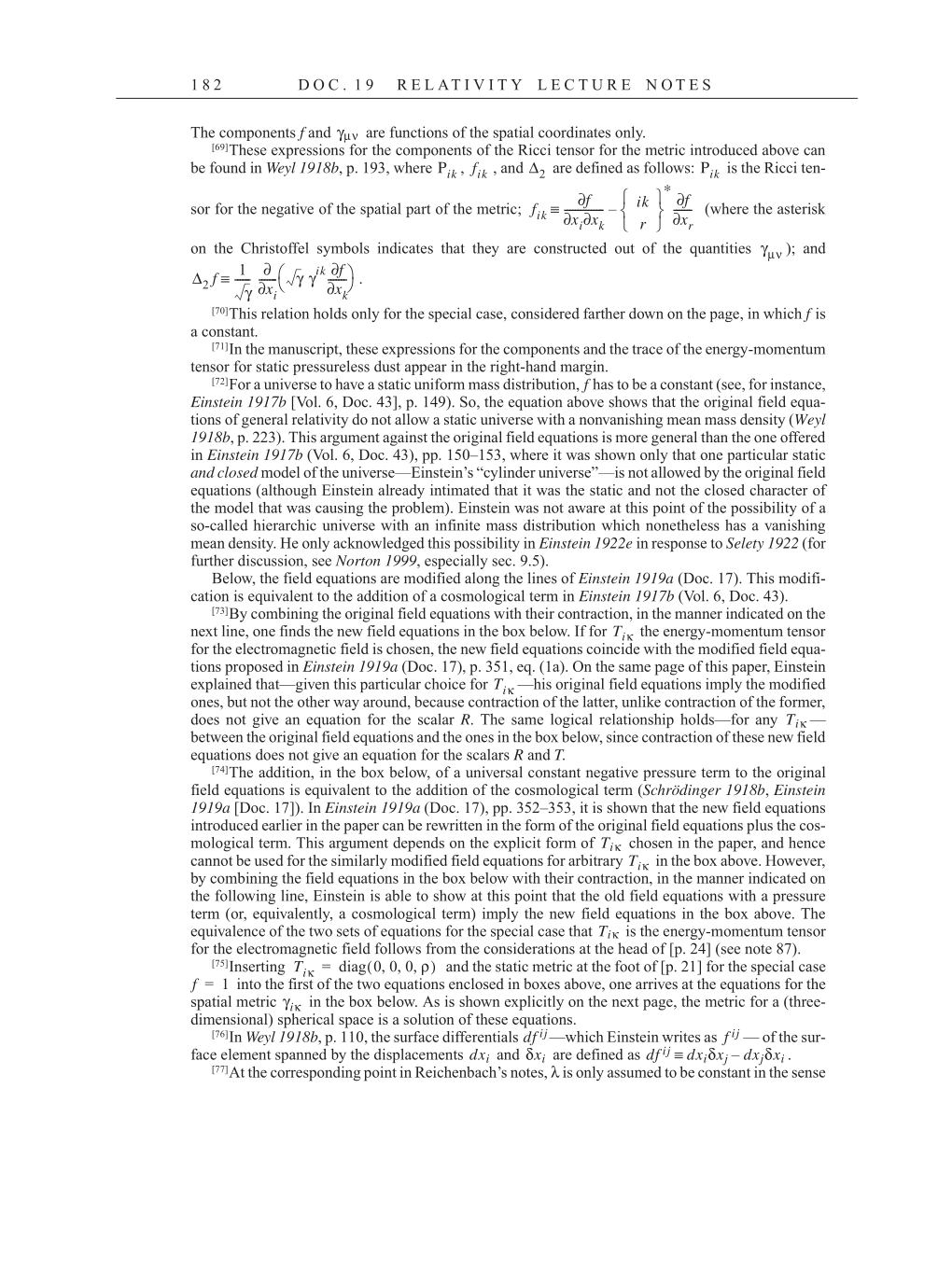1 8 2 D O C . 1 9 R E L AT I V I T Y L E C T U R E N O T E S
The components f and are functions of the spatial coordinates only.
[69]These expressions for the components of the Ricci tensor for the metric introduced above can
be found in Weyl 1918b, p. 193, where , , and are defined as follows: is the Ricci ten-
sor for the negative of the spatial part of the metric; (where the asterisk
on the Christoffel symbols indicates that they are constructed out of the quantities ); and
.
[70]This relation holds only for the special case, considered farther down on the page, in which f is
a constant.
[71]In the manuscript, these expressions for the components and the trace of the energy-momentum
tensor for static pressureless dust appear in the right-hand margin.
[72]For a universe to have a static uniform mass distribution, f has to be a constant (see, for instance,
Einstein 1917b [Vol. 6, Doc. 43], p. 149). So, the equation above shows that the original field equa-
tions of general relativity do not allow a static universe with a nonvanishing mean mass density (Weyl
1918b, p. 223). This argument against the original field equations is more general than the one offered
in Einstein 1917b (Vol. 6, Doc. 43), pp. 150–153, where it was shown only that one particular static
and closed model of the universe—Einstein’s “cylinder universe”—is not allowed by the original field
equations (although Einstein already intimated that it was the static and not the closed character of
the model that was causing the problem). Einstein was not aware at this point of the possibility of a
so-called hierarchic universe with an infinite mass distribution which nonetheless has a vanishing
mean density. He only acknowledged this possibility in Einstein 1922e in response to Selety 1922 (for
further discussion, see Norton 1999, especially sec. 9.5).
Below, the field equations are modified along the lines of Einstein 1919a (Doc. 17). This modifi-
cation is equivalent to the addition of a cosmological term in Einstein 1917b (Vol. 6, Doc. 43).
[73]By combining the original field equations with their contraction, in the manner indicated on the
next line, one finds the new field equations in the box below. If for the energy-momentum tensor
for the electromagnetic field is chosen, the new field equations coincide with the modified field equa-
tions proposed in Einstein 1919a (Doc. 17), p. 351, eq. (1a). On the same page of this paper, Einstein
explained that—given this particular choice for —his original field equations imply the modified
ones, but not the other way around, because contraction of the latter, unlike contraction of the former,
does not give an equation for the scalar R. The same logical relationship holds—for any —
between the original field equations and the ones in the box below, since contraction of these new field
equations does not give an equation for the scalars R and T.
[74]The addition, in the box below, of a universal constant negative pressure term to the original
field equations is equivalent to the addition of the cosmological term (Schrödinger 1918b, Einstein
1919a [Doc. 17]). In Einstein 1919a (Doc. 17), pp. 352–353, it is shown that the new field equations
introduced earlier in the paper can be rewritten in the form of the original field equations plus the cos-
mological term. This argument depends on the explicit form of chosen in the paper, and hence
cannot be used for the similarly modified field equations for arbitrary in the box above. However,
by combining the field equations in the box below with their contraction, in the manner indicated on
the following line, Einstein is able to show at this point that the old field equations with a pressure
term (or, equivalently, a cosmological term) imply the new field equations in the box above. The
equivalence of the two sets of equations for the special case that is the energy-momentum tensor
for the electromagnetic field follows from the considerations at the head of [p. 24] (see note 87).
[75]Inserting and the static metric at the foot of [p. 21] for the special case
into the first of the two equations enclosed in boxes above, one arrives at the equations for the
spatial metric in the box below. As is shown explicitly on the next page, the metric for a (three-
dimensional) spherical space is a solution of these equations.
[76]In Weyl 1918b, p. 110, the surface differentials —which Einstein writes as — of the sur-
face element spanned by the displacements and are defined as .
[77]At the corresponding point in Reichenbach’s notes, λ is only assumed to be constant in the sense
γμν
Ρik fik Δ2 Ρik
fik
∂f
∂xi∂xk
-------------- -
ik
r
î þ
í ý
ì ü
∗
∂f
∂xr
------- – ≡
γμν
Δ2 f
1
γ
------
∂
∂xiè
------æ
- γ
γik-------ö
∂f
∂xkø
≡
Tiκ
Tiκ
Tiκ
Tiκ
Tiκ
Tiκ
Tiκ diag 0 0 0, ρ) , , ( =
f 1 =
γiκ
df
ij
f
ij
dxi δxi df ij dxiδxj dxjδxi – ≡
